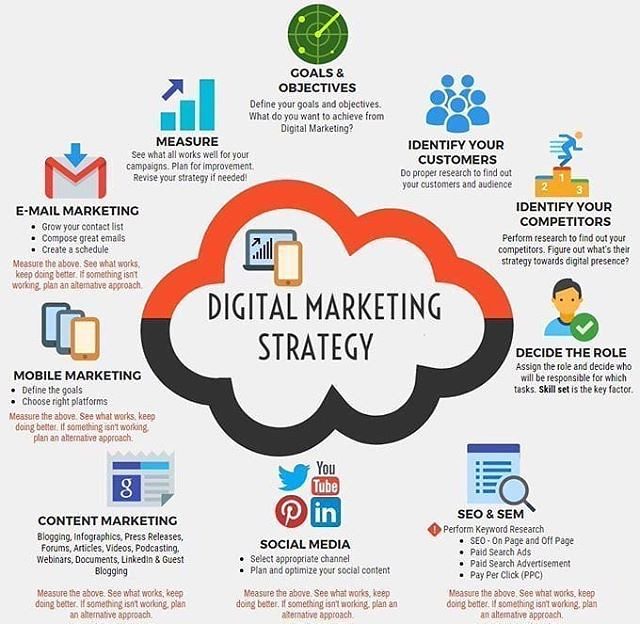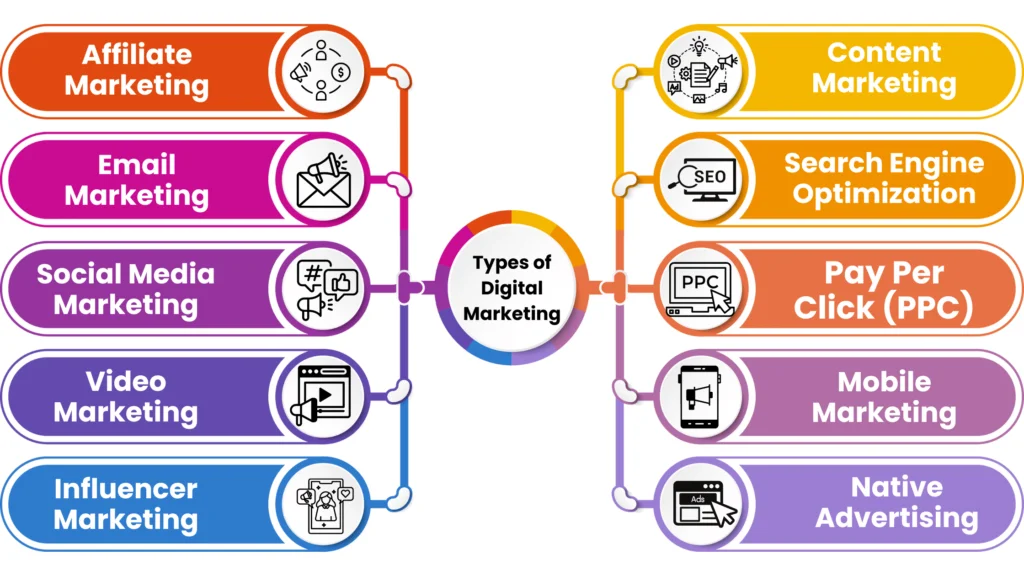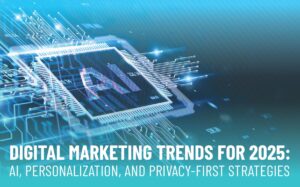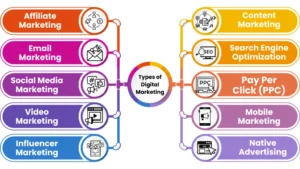
Digital marketing refers to the use of online channels, platforms, and technologies to promote products or services. It includes a range of tactics such as social media marketing, search engine optimization (SEO), email marketing, and paid advertising. Businesses leverage digital marketing to connect with their audience, drive engagement, and achieve their goals effectively.
A recent study found that over 4.95 billion people actively use the internet, with social media playing a significant role in online interactions. With consumers spending an average of 2.5 hours per day on social platforms, businesses that invest in a well-structured social media marketing strategy can significantly improve brand awareness and customer engagement.
This guide explores key strategies for effective Digital marketing, covering platform selection, content planning, audience engagement, and performance tracking. Whether you’re a startup or an established brand, you’ll find practical insights to enhance your marketing efforts and achieve measurable results.
What is Digital Marketing?
Digital marketing is the promotion of products or services using online channels such as social media, search engines, email, and websites. It helps businesses connect with their audience and drive engagement through targeted strategies.
With over 5.3 billion internet users worldwide, digital platforms have become essential for businesses. Consumers now rely on online content, reviews, and ads to make purchasing decisions, making digital marketing a key driver of brand visibility.
Studies show that 76% of consumers research brands online before making a purchase. A strong digital marketing strategy ensures businesses stay competitive, reach the right audience, and maximize growth opportunities.
A digital marketing strategy is a structured plan that businesses use to promote their products or services online. It outlines goals, target audiences, key channels, and the tactics needed to drive engagement, conversions, and revenue growth.
How a SaaS Giant Converts Leads into Customers
HubSpot, a leader in B2B marketing, relies on content and SEO to attract businesses looking for marketing solutions. Their strategy includes in-depth blogs, free tools, and educational webinars that guide potential customers through the buying journey. This approach has positioned them as an industry authority while driving consistent lead generation.
How a Sportswear Brand Creates Viral Engagement
Nike dominates B2C marketing with a blend of storytelling, influencer collaborations, and digital campaigns. Through platforms like Instagram and TikTok, they feature real athletes, social movements, and interactive challenges, turning customers into brand advocates and boosting direct-to-consumer sales.
With the right strategy, businesses can build meaningful connections and sustain long-term growth in the digital space.

How to Create an Effective Digital Marketing Strategy
1️⃣ Conduct Market Research and Understand Your Audience
2️⃣ Set Clear Digital Marketing Goals
3️⃣ Develop a Content Marketing Strategy
4️⃣ Optimize for SEO
5️⃣ Choose the Right Digital Marketing Channels
6️⃣ Implement and Optimize Digital Marketing Campaigns
7️⃣ Use Technology and Automation
8️⃣ Establish a Feedback Loop
9️⃣ Allocate Budget and Resources
Step 1: Conduct Market Research and Understand Your Audience
Identify Your Target Audience
- Use demographic data, behavior analysis, and segmentation to refine your audience.
- Create detailed buyer personas based on preferences, behaviors, and pain points.
- Example: A fitness brand launching an online workout program identifies its ideal customer as 25-40-year-old professionals who prefer at-home workouts due to busy schedules. They refine their content to address time-efficient fitness routines.
Analyze Competitors
- Assess their strengths, weaknesses, and strategies.
- Identify gaps and opportunities to differentiate your approach.
- Example: A new organic skincare brand studies competitors and finds that most lack educational content on ingredient benefits. They capitalize on this by producing detailed blogs and social media posts explaining their product ingredients and benefits.
Step 2: Set Clear Digital Marketing Goals
Define SMART Goals
- Set Specific, Measurable, Achievable, Relevant, and Time-bound (SMART) objectives.
- Example: An e-commerce brand aims to increase website traffic by 30% within three months through SEO and social media campaigns.
Establish Key Performance Indicators (KPIs)
- Track essential metrics to measure success:
- Engagement rate: Likes, shares, comments
- Conversion rate: Leads, purchases, sign-ups
- Website traffic: Organic, paid, referral sources
- Example: A SaaS company monitors trial sign-ups and conversion rates to evaluate the effectiveness of its content marketing strategy.
Step 3: Develop a Content Marketing Strategy
Create Engaging Content
- Develop valuable and unique content tailored to audience needs:
- Blog posts to educate and inform
- Videos for high engagement
- Social media content to increase brand visibility
- Example: A travel agency publishes blog articles on “Best Budget-Friendly Destinations” and creates Instagram reels showcasing hidden travel gems, driving traffic to their website.
Use a Content Calendar
- Plan and schedule content in advance to maintain consistency.
- Example: A tech brand releases a weekly blog and monthly webinar about industry trends, ensuring regular audience engagement.
Step 4: Optimize for SEO
Keyword Research
- Identify relevant keywords to improve search engine rankings.
- Use tools like Google Keyword Planner or SEMrush to find high-traffic, low-competition keywords.
- Example: A local bakery discovers that “best gluten-free cakes near me” has high search volume and optimizes content around this keyword to attract local customers.
Optimize Website and Content
- Ensure your website is mobile-friendly and loads quickly.
- Use SEO best practices like meta descriptions, alt text for images, and internal linking.
- Example: An online fashion store improves its site speed and optimizes product descriptions with relevant keywords, leading to better search rankings and increased sales.
Step 5: Choose the Right Digital Marketing Channels
| Digital Marketing Channel | Best Practices | Example |
| Social Media | Choose platforms based on audience (Facebook, Instagram, LinkedIn). Use engaging visuals & interactive content. | Example: A B2B software company shares industry insights & case studies on LinkedIn, attracting professional leads. |
| Email Marketing | Segment and personalize campaigns. Send emails based on user behavior & preferences. | Example: An online bookstore sends personalized book recommendations based on past purchases, increasing repeat sales. |
| Paid Advertising | Use Google Ads & social media ads for precise targeting. Optimize ad copy & visuals for better CTR. | Example: A fitness app runs Facebook Ads targeting home workout enthusiasts, leading to a surge in downloads. |
Step 6: Implement and Optimize Digital Marketing Campaigns
Launch Campaigns
- Execute your strategies across chosen digital marketing channels.
- Ensure messaging is consistent and aligned with brand identity.
- Example: A luxury watch brand launches a multi-channel campaign, combining Instagram influencer partnerships and YouTube ads for maximum impact.
Monitor Performance
- Use tools like Google Analytics, Facebook Insights, and HubSpot to track performance metrics.
- Continuously analyze data and optimize strategies based on insights.
- Example: A travel agency tracks social media engagement and adjusts ad spending based on which platform generates the most leads.
Step 7: Use Technology and Automation
Marketing Automation Tools
- Streamline repetitive tasks like email campaigns, social media scheduling, and lead nurturing.
- Use tools like HubSpot, Mailchimp, or ActiveCampaign to automate workflows.
AI and Analytics Tools
- Leverage AI for:
- Content generation (e.g., ChatGPT for blog ideas, Jasper for ad copy).
- Predictive analytics to understand customer behavior and improve targeting.
Example: A fitness brand used AI-powered chatbots for customer support and automated email follow-ups. This increased engagement by 40% and reduced manual workload by 60%.
Step 8: Establish a Feedback Loop
Regularly Review Performance
- Analyze key metrics using Google Analytics, Facebook Business Manager, and CRM reports.
- Monitor trends in traffic, conversion rates, bounce rates, and customer engagement.
Adapt and Refine Strategies
- Use A/B testing to optimize:
- Ad creatives
- Landing pages
- Email subject lines
Example: An online fashion retailer noticed a high cart abandonment rate. By implementing exit-intent pop-ups and optimizing checkout UX, they boosted conversions by 25%.
Step 9: Allocate Budget and Resources
Budget Allocation
- Prioritize high-performing channels:
- SEO & content marketing for long-term growth.
- Paid ads for quick wins and targeted reach.
- Email marketing for high ROI with minimal cost.
Team Roles & Responsibilities
- Assign clear responsibilities across:
- Content creation (writers, designers)
- Ad management (PPC specialists)
- SEO optimization (SEO strategists)
- Campaign analysis (data analysts)
Example: A B2B SaaS company reallocated 30% of its PPC budget to content marketing. By focusing on educational blogs and LinkedIn thought leadership, they generated 3x more inbound leads at a lower cost per acquisition.
Why Digital Marketing Strategy is Crucial in 2025

1. AI-Driven Personalization and Automation
Importance: AI enables brands to deliver personalized experiences at scale, enhancing customer engagement and loyalty. It automates repetitive tasks, freeing marketers to focus on strategic planning and creativity.
Impact: AI-driven personalization tailors marketing messages to individual customer needs, improving conversion rates and customer satisfaction. Businesses leveraging AI gain a competitive edge through better customer interactions and predictive analytics.
2. Omnichannel Marketing for Seamless Experiences
Importance: Consumers interact with brands across multiple platforms, making integrated marketing efforts essential for a cohesive brand experience.
Impact: A strong omnichannel strategy ensures consistent messaging, visuals, and targeting across platforms, reinforcing brand identity and building consumer trust. This approach drives engagement and customer retention.
3. Data-Driven Decision Making
Importance: Data analytics empower businesses to make informed decisions, optimize campaigns, and personalize customer experiences.
Impact: Utilizing data-driven strategies leads to faster, more precise decision-making and increased profitability. Businesses can refine marketing efforts based on customer behaviors and preferences, improving ROI.
4. Sustainability and Social Responsibility
Importance: Consumers increasingly choose brands that align with their values on sustainability and corporate responsibility.
Impact: Demonstrating a commitment to sustainability fosters brand loyalty and attracts socially conscious consumers. Ethical marketing enhances brand reputation, differentiating businesses in a competitive marketplace.
5. Adaptability and Agility in a Changing Landscape
Importance: Rapid technological advancements and evolving regulations demand marketing agility and continuous innovation.
Impact: Brands that quickly adapt to new trends, technologies, and regulatory changes maintain a competitive advantage. Agility in marketing strategies ensures long-term success and consumer trust.
Top Digital Marketing Tips for 2025

1. Leverage AI for Personalization and Efficiency
Tip: Use AI to personalize customer experiences and automate repetitive tasks, streamlining workflows and enhancing campaign efficiency.
Action: Implement AI-driven tools in social media, email marketing, and SEO to optimize targeting and improve performance.
2. Adopt an Omnichannel Approach
Tip: Ensure a seamless brand experience across all platforms, including social media, email, and search engines, to build trust and reinforce brand identity.
Action: Create a cohesive campaign calendar that integrates messaging, visuals, and targeting across all channels.
3. Optimize for Voice and Visual Search
Tip: With the rise of voice and visual search, optimize content by incorporating structured data and high-quality images with alt tags.
Action: Use conversational search formats and create content that directly answers common user queries to improve search visibility.
4. Focus on Authentic Branding and Sustainability
Tip: Consumers prioritize authenticity and sustainability. Leverage user-generated content (UGC) and align with social causes to foster deeper connections.
Action: Develop a brand identity that reflects your values and showcases social responsibility through purpose-driven marketing.
5. Emphasize Data Privacy and the Personalization Balance
Tip: Balance personalization with data privacy by leveraging zero-party data—information customers willingly share.
Action: Implement strategies that respect customer privacy while delivering personalized experiences to enhance trust and loyalty.
What Are Some Advantages of Digital Marketing Over Traditional Marketing Methods?

Advantage | Key Benefits | Example/Stat |
1. Cost-Effectiveness |
| Stat: Businesses save up to 62% with digital marketing compared to traditional methods. |
2. Better Targeting & Personalization |
| Stat: 89% of marketers say data analytics enhances customer experience strategy. |
3. Greater Audience Reach & Engagement |
| Example: A small startup goes viral on TikTok, reaching millions at no extra cost.A |
4.Measurable & Data-Driven Results |
| Stat: 89% of marketers say data analytics enhances customer experience strategy. |
Faster & More Flexible Campaign Execution |
| Example: Brands adjust messaging in real time based on trends. |
Improved Customer Interaction & Trust Building |
| Stat: 92% of consumers trust online reviews as much as personal recommendations. |
Conclusion: Crafting a Future-Proof Digital Marketing Strategy
In 2025, a successful digital marketing strategy is built on data-driven insights, AI-powered automation, and customer-centric engagement. Businesses that leverage SEO, social media, paid ads, email marketing, and personalization will stay ahead of the competition.






